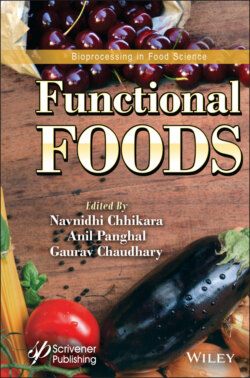Читать книгу Functional Foods - Группа авторов - Страница 41
3.2.3 Oat
ОглавлениеOat is a cereal that has multifunctional uses including human food, animal feed, and health effects [77, 78]. The production of oat is in 6th place among grains worldwide, respectively following maize, wheat, barley, sorghum, and millet [79]. The world’s oat cultivation area is significantly smaller than that of some of these other grains [77 ,78], related to lower oat yields in comparison to other cereal yields [78, 80]. Oat accounts for >2% of the total global cereal production [79]. Oats are resistant to damp weather conditions and acidic soil. They are also generally disease-resistant. Also, they require less agricultural chemicals and fertilizer input [78, 81]. The production costs of oats can be similar to barley or wheat [78]. Nowadays, the main oat producers are Russia, Canada, the United States, and Northern Europe [82]. Global oat production is slightly more than 25 million tons per year [79]. According to the oat taxonomy given by Youngs et al., oat species are categorized as diploid, tetraploid, and hexaploid oats [82, 83]. The majority of oats being grown these days are members of the hexaploid group of species. Avena sativa L., more popularly known as common white oat, is this group’s most widely utilized species. It is raised and harvested in the world’s temperate areas. Avena nuda (naked oat) provides groats, the hulls of which are removed in threshing. Due to their excellent grain quality, naked oats are desirable among producers and in various industries, and especially for specialty markets. However, this species has low yields and it is susceptible to both mechanical damage and mold [82, 84]. Avena byzantina, or the common red oat, is commonly harvested in the winter season in the south of the United States. Today, the majority of the varieties of oat that are being grown have come about as crosses of Avena sativa with Avena byzantina [82].
The oat grain comprises the groat, which in turn is enclosed within the external hull layer [79, 85]. Although structural differences between assorted varieties of oats have been highlighted by various researchers, generally speaking, an oat grain has a shell (25%); the pericarp, testa, and aleurone (9%); the endosperm (63%), which is a starchy substance; and the embryo (3%) [86]. Hulls must be separated from the groats before the beginning of the processing [85, 87]. After being dehulled, these grains or groats constitute approximately 75% of the whole grain’s total; this figure fluctuates between 65% and 80% due to both diversity and environmental differences [86]. Oat is generally consumed whole as oat flakes [85]. The metabolizable energy content of whole oats is 2.5 to 2.6 kcal/g, and it is quite low [88]. The highly nutritious nature of oat species means that they are beneficial components of human and animal diets [78]. The typical protein value of whole oats is 10%–12% [86, 89] and this value is similar to that of wheat [86]. Meanwhile, oats have amino acid contents that are better than those found in other grain species due to the main protein being globulin [78, 90]. Compared to prolamins, which are grain storage proteins, globulins contain higher amounts of lysine and other essential amino acids [78, 91]. Oats also contain high levels of lipids [78, 84, 92, 93]. The lipid concentration of oat groats is 2 to 5 times higher than that present in wheat. Lipid contents can reach amounts of up to 10% of the total oat mass [93,94]. The major fatty acids in oatmeal can be listed as linoleic acid (38%), oleic acid (36%), and palmitic acid (19%), followed by linolenic acid (2%) and stearic acid (2%). The water content of oatmeal is 8.5% and the ash content is 1.8%. About 57.8% of oatmeal consists of carbohydrates, so it can be said to be a valuable source for obtaining dietary fiber [79]. Total sugar contents of oats are about 1%, while reducing sugar contents are less than 0.1% [86, 95]. Meanwhile, there are rising levels of interest in the consumption of oat-derived food items due to the requirement for soluble fibers in the human diet, and especially β-glucans, having valuable health-promoting effects [78, 96–98]. 1,3- and 1,4-β-Glucans are present as 2% to 6% of the total mass of groats and 7% of the starchy endosperm [86, 99, 100]. β-Glucans create viscous gums with water [86, 101] and contribute to water retention capacity, processing behavior, and viscosity [86, 102]. As the most highly abundant component of oats, starch accounts for 60% of whole oat grain’s dry matter. Oat starch’s iodine affinity is about 19.5%. This is reasonably close to the values of wheat, rye, and barley [86, 103]. Also, the α-tocopherol content of oat grain is 4.5–12.3 mg/kg and can be considered as high [104].
In the daily diet, the consumption of oats, which contain β-glucan polysaccharides, various dietary fiber components, and antioxidant compounds like tocopherol, wields a positive influence on consumer health and decreases the risks of various illnesses and malignancies [104]. In many studies, the valuable fiber components in oats were found to exert both therapeutic and protective activities against cardiovascular diseases, type-2 diabetes mellitus, and various types of cancer, like colon cancer [105–109]. The β-glucans found in oats are reported to have an association with oat’s ability to lower blood cholesterol levels [109]. New data also show that oats positively affect body weight and blood pressure [79].
